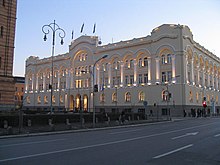Bosanska Krajina
Bosanska Krajina ( Cyrillic Босанска Крајина , or also called Bosnian Krajina ) is a name for a historical landscape in the northwest of Bosnia and Herzegovina . The name translates as 'Bosnian border area' (see Krajina ). The most culturally and historically important cities are Banja Luka and Bihać .
geography
The three rivers Una , Sana and Vrbas run through the area . The landscape lies in the northern part of the Dinaric Mountains and is relatively densely forested outside the cities.
The Bosanska Krajina has no administrative boundaries. It extends in the west from today's canton Una-Sana to the region of Banja Luka in today's Republika Srpska . The area is of great importance for the culture and history of Bosnia and partly Croatia .
Localities
The following larger towns are in the Bosanska Krajina:
- Banja Luka (199,191 inhabitants)
- Prijedor (97,588 inhabitants)
- Cazin (69,411 inhabitants)
- Bihać (61,186 inhabitants)
- Bosanska Gradiška (56,727 inhabitants)
- Velika Kladuša (44,770 inhabitants)
- Sanski Most (47,359 inhabitants)
- Bosanska Krupa (29,659 inhabitants)
- Novi Grad (28,799 inhabitants)
- Bosanska Dubica (23,074 inhabitants)
- Laktaši (24,966 inhabitants)
- Ključ (18,741 inhabitants)
- Bužim (20,298 inhabitants)
- Bosanski Petrovac (7,946 inhabitants)
history
Until the 15th century , most of the area of today's Bosanska Krajina belonged to the Kingdom of Hungary. After a large part of the Balkan Peninsula was conquered by the Ottoman Empire during the 15th and 16th centuries, the Bosanska Krajina was also incorporated into Ottoman Bosnia . During the 18th and 19th centuries, the area was known as Turska Hrvatska (in German: Turkish Croatia ) before it was given its current name around 1860.
For centuries the Bosanska Krajina formed the Ottoman counterpart to the Austrian military border (Vojna Krajina) , which it enclosed in the north and west.
Before the Bosnian War , Banja Luka - by far the largest city in the Bosanska Krajina - had several museums that dealt with the history of this region, such as the Muzej Bosanske Krajine . After the war it was renamed Museum of Republic of Srpska due to the general rejection of the term Bosnian by the authorities of the Republika Srpska . In the Bosniak-dominated canton Una-Sana, however, the name is still in use.
literature
- Mučibabić B., Ed. (1998). Geografski atlas Bosne i Hercegovine. Sarajevo: Geodetski zavod BiH. ISBN 9958-766-00-0 .
- Gregurović, Snježana; Mlinarić, Dubravka (December 2011). Kartografska vizualizacija i slika Drugoga na primjeru višestruko graničnih prostora, Migracijske i etničke teme. Zagreb: Institut za migracije i narodnosti, page 354 ff.
Individual evidence
- ↑ http://www.euratlas.net/history/europe/1400/de_index.html
- ↑ Archive link ( Memento of the original from May 18, 2017 in the Internet Archive ) Info: The archive link was inserted automatically and has not yet been checked. Please check the original and archive link according to the instructions and then remove this notice.


